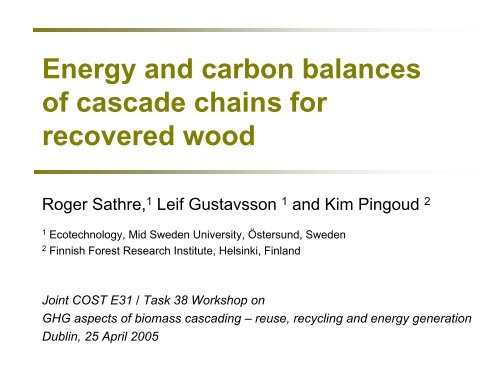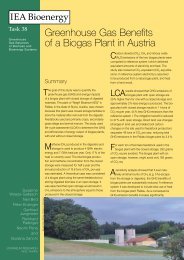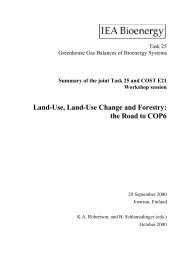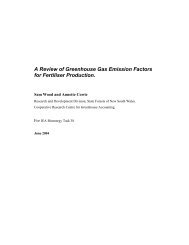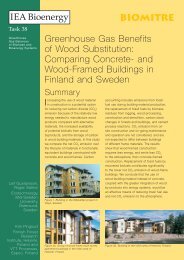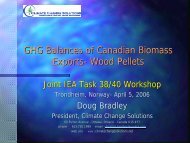Energy and carbon balances of cascade chains for recovered wood
Energy and carbon balances of cascade chains for recovered wood
Energy and carbon balances of cascade chains for recovered wood
You also want an ePaper? Increase the reach of your titles
YUMPU automatically turns print PDFs into web optimized ePapers that Google loves.
Indirect <strong>cascade</strong> effectsCascading means more service per unit <strong>of</strong> virgin<strong>wood</strong>, or less virgin <strong>wood</strong> per unit <strong>of</strong> service...If l<strong>and</strong> is not needed <strong>for</strong> <strong>wood</strong> production, whatwill it be used <strong>for</strong>?• C sequestration• Bi<strong>of</strong>uel• Other <strong>wood</strong> productsThis also applies to substitution by non-<strong>wood</strong> materialSathre, Gustavsson <strong>and</strong> Pingoud: <strong>Energy</strong> <strong>and</strong> <strong>carbon</strong> <strong>balances</strong> <strong>of</strong> <strong>cascade</strong> <strong>chains</strong> <strong>for</strong> <strong>recovered</strong> <strong>wood</strong>Joint COST E31/Task 38 Workshop on GHG aspects <strong>of</strong> biomass cascading, 25 April 2005, Dublin
Material substitution effectsUsing <strong>wood</strong> instead <strong>of</strong> other materials• E.g. <strong>wood</strong> structure instead <strong>of</strong> rein<strong>for</strong>cedconcrete; plasterboard instead <strong>of</strong> particleboard• Differences in production energy <strong>and</strong> <strong>recovered</strong>energy• Non-energy <strong>carbon</strong> emissions (e.g. calcination)Material substitution is not directly related to cascading,but can affect results <strong>of</strong> analysisSathre, Gustavsson <strong>and</strong> Pingoud: <strong>Energy</strong> <strong>and</strong> <strong>carbon</strong> <strong>balances</strong> <strong>of</strong> <strong>cascade</strong> <strong>chains</strong> <strong>for</strong> <strong>recovered</strong> <strong>wood</strong>Joint COST E31/Task 38 Workshop on GHG aspects <strong>of</strong> biomass cascading, 25 April 2005, Dublin
Our methodology• Micro-level analysis <strong>of</strong> marginal changes• We calculate energy <strong>and</strong> <strong>carbon</strong> <strong>balances</strong>over the lifecycle <strong>of</strong> product <strong>chains</strong>• Damaged or contaminated <strong>wood</strong> is notconsideredSathre, Gustavsson <strong>and</strong> Pingoud: <strong>Energy</strong> <strong>and</strong> <strong>carbon</strong> <strong>balances</strong> <strong>of</strong> <strong>cascade</strong> <strong>chains</strong> <strong>for</strong> <strong>recovered</strong> <strong>wood</strong>Joint COST E31/Task 38 Workshop on GHG aspects <strong>of</strong> biomass cascading, 25 April 2005, Dublin
Methodology• Begin each analysis with 1000 kg clean<strong>recovered</strong> <strong>wood</strong> at 15% moisture content• Forest l<strong>and</strong> needed to produce RW is either:– not included (assumes <strong>for</strong>est is limitingresource)– included (examines alternative uses <strong>for</strong><strong>for</strong>est resource)Sathre, Gustavsson <strong>and</strong> Pingoud: <strong>Energy</strong> <strong>and</strong> <strong>carbon</strong> <strong>balances</strong> <strong>of</strong> <strong>cascade</strong> <strong>chains</strong> <strong>for</strong> <strong>recovered</strong> <strong>wood</strong>Joint COST E31/Task 38 Workshop on GHG aspects <strong>of</strong> biomass cascading, 25 April 2005, Dublin
Relation between harvest, RW <strong>and</strong> <strong>for</strong>est growthharvested<strong>wood</strong><strong>recovered</strong><strong>wood</strong>Wood <strong>recovered</strong> today washarvested 100 years ag<strong>of</strong>orest biomassForest has regrown-100time (yrs)0Sathre, Gustavsson <strong>and</strong> Pingoud: <strong>Energy</strong> <strong>and</strong> <strong>carbon</strong> <strong>balances</strong> <strong>of</strong> <strong>cascade</strong> <strong>chains</strong> <strong>for</strong> <strong>recovered</strong> <strong>wood</strong>Joint COST E31/Task 38 Workshop on GHG aspects <strong>of</strong> biomass cascading, 25 April 2005, Dublin
Relation between harvest, RW <strong>and</strong> <strong>for</strong>est growthharvested<strong>wood</strong><strong>recovered</strong><strong>wood</strong>If <strong>for</strong>est is not harvested,it will either stop growing orgrow at half original rate<strong>for</strong>est biomassharvested<strong>wood</strong>50% growth <strong>of</strong> mature <strong>for</strong>estregrowth after harvest0% growth <strong>of</strong> mature <strong>for</strong>est-100 time (yrs)0100If <strong>for</strong>est is harvested now,it will regrow in 100 yearsSathre, Gustavsson <strong>and</strong> Pingoud: <strong>Energy</strong> <strong>and</strong> <strong>carbon</strong> <strong>balances</strong> <strong>of</strong> <strong>cascade</strong> <strong>chains</strong> <strong>for</strong> <strong>recovered</strong> <strong>wood</strong>Joint COST E31/Task 38 Workshop on GHG aspects <strong>of</strong> biomass cascading, 25 April 2005, Dublin
<strong>Energy</strong> balance+ Primary energy (PE) <strong>for</strong> <strong>wood</strong> recovery+ PE <strong>for</strong> <strong>for</strong>est management <strong>and</strong> harvest+ PE <strong>for</strong> material transport <strong>and</strong> processing– Heating value <strong>of</strong> logging <strong>and</strong> processing residuesused as fuel– Heating value <strong>of</strong> RW used as fuelSathre, Gustavsson <strong>and</strong> Pingoud: <strong>Energy</strong> <strong>and</strong> <strong>carbon</strong> <strong>balances</strong> <strong>of</strong> <strong>cascade</strong> <strong>chains</strong> <strong>for</strong> <strong>recovered</strong> <strong>wood</strong>Joint COST E31/Task 38 Workshop on GHG aspects <strong>of</strong> biomass cascading, 25 April 2005, Dublin
<strong>Energy</strong> used <strong>for</strong> biomass logisticsExpressed as percent <strong>of</strong> Heat Value <strong>of</strong> <strong>wood</strong>• Round<strong>wood</strong> harvest / transport 2.8 %• Logging residue recovery / transport 5 %• Sawmill residue recovery / transport 1 %• Chipping <strong>of</strong> round<strong>wood</strong> 1 %• Recovery (deconstruction) / transport<strong>of</strong> <strong>wood</strong> <strong>for</strong> reuse 3 %• Recovery (demolition) / transport<strong>of</strong> <strong>wood</strong> <strong>for</strong> fuel 1 %• Forest management 0.3 %Sathre, Gustavsson <strong>and</strong> Pingoud: <strong>Energy</strong> <strong>and</strong> <strong>carbon</strong> <strong>balances</strong> <strong>of</strong> <strong>cascade</strong> <strong>chains</strong> <strong>for</strong> <strong>recovered</strong> <strong>wood</strong>Joint COST E31/Task 38 Workshop on GHG aspects <strong>of</strong> biomass cascading, 25 April 2005, Dublin
Amounts <strong>and</strong> properties <strong>of</strong> bi<strong>of</strong>uelsSourceRecovery(%)MoistureContent(%)HeatingValue(MJ/kg)Recovered <strong>wood</strong> 100 15 18.6Sawmill residues 100 50 16.6Round<strong>wood</strong> <strong>for</strong> bi<strong>of</strong>uel 100 60 15.3Bark 100 60 15.3Branches, foliage, tops 70 60 15.3Roots <strong>and</strong> stumps 0 - -Sathre, Gustavsson <strong>and</strong> Pingoud: <strong>Energy</strong> <strong>and</strong> <strong>carbon</strong> <strong>balances</strong> <strong>of</strong> <strong>cascade</strong> <strong>chains</strong> <strong>for</strong> <strong>recovered</strong> <strong>wood</strong>Joint COST E31/Task 38 Workshop on GHG aspects <strong>of</strong> biomass cascading, 25 April 2005, Dublin
<strong>Energy</strong> <strong>for</strong> material processing(MJ/kg)Electricity Petroleum Coal NG Bi<strong>of</strong>uelLumber 0.41 2.26 0 0 1.88Particleboard (virgin <strong>wood</strong>) 1.08 2.79 0 0 2.50Particleboard (<strong>recovered</strong> <strong>wood</strong>) 1.18 1.33 0 0 1.05Pulp (mechanical process) 5.40 0 0 0 0Concrete 0.07 0.21 0.37 0 0Steel (from scrap) 2.19 0.36 0.28 1.95 0Plasterboard 0.55 3.73 0 0 0Note: <strong>wood</strong> products energy starts at factory gateother products include raw material extractionSathre, Gustavsson <strong>and</strong> Pingoud: <strong>Energy</strong> <strong>and</strong> <strong>carbon</strong> <strong>balances</strong> <strong>of</strong> <strong>cascade</strong> <strong>chains</strong> <strong>for</strong> <strong>recovered</strong> <strong>wood</strong>Joint COST E31/Task 38 Workshop on GHG aspects <strong>of</strong> biomass cascading, 25 April 2005, Dublin
Carbon balance+ CO 2 emission from fossil fuel combustion+ CO 2 emission from non-energy processreactions– CO 2 emission avoided by replacing fossil fuelby <strong>recovered</strong> bi<strong>of</strong>uel– increased (or + decreased) C stock in <strong>for</strong>est<strong>and</strong> productsSathre, Gustavsson <strong>and</strong> Pingoud: <strong>Energy</strong> <strong>and</strong> <strong>carbon</strong> <strong>balances</strong> <strong>of</strong> <strong>cascade</strong> <strong>chains</strong> <strong>for</strong> <strong>recovered</strong> <strong>wood</strong>Joint COST E31/Task 38 Workshop on GHG aspects <strong>of</strong> biomass cascading, 25 April 2005, Dublin
Specific CO 2 emissionsSourcekg C / GJCoal 30Petroleum 22Natural gas 18Biomass 0Coal-fired electricity 77NG-fired electricity 37Specific emission fromfossil fuelsinclude full fuel cycleFossil emissionsassociated with bi<strong>of</strong>uelare calculated separatelyWe assume bi<strong>of</strong>uel replaces coal at 100% efficiency<strong>and</strong> NG at 96% efficiencySathre, Gustavsson <strong>and</strong> Pingoud: <strong>Energy</strong> <strong>and</strong> <strong>carbon</strong> <strong>balances</strong> <strong>of</strong> <strong>cascade</strong> <strong>chains</strong> <strong>for</strong> <strong>recovered</strong> <strong>wood</strong>Joint COST E31/Task 38 Workshop on GHG aspects <strong>of</strong> biomass cascading, 25 April 2005, Dublin
Carbon stocks• Forest biomass is 50% C• Stumps, roots <strong>and</strong> un<strong>recovered</strong> loggingresidues are assumed oxidized to CO 2• We don’t consider C in soil• Wood products are burned with energyrecovery at end <strong>of</strong> <strong>cascade</strong>Sathre, Gustavsson <strong>and</strong> Pingoud: <strong>Energy</strong> <strong>and</strong> <strong>carbon</strong> <strong>balances</strong> <strong>of</strong> <strong>cascade</strong> <strong>chains</strong> <strong>for</strong> <strong>recovered</strong> <strong>wood</strong>Joint COST E31/Task 38 Workshop on GHG aspects <strong>of</strong> biomass cascading, 25 April 2005, Dublin
Analysed <strong>cascade</strong> <strong>chains</strong>1. Particleboard made <strong>of</strong> RW or virgin <strong>wood</strong>2a. Building frame (<strong>for</strong>est limited)2b. Building frame (<strong>for</strong>est not limited)3a. Building frame + particleboard (<strong>for</strong>est limited)3b. Building frame + particleboard (<strong>for</strong>est notlimited)4. Building frame + particleboard + pulpSathre, Gustavsson <strong>and</strong> Pingoud: <strong>Energy</strong> <strong>and</strong> <strong>carbon</strong> <strong>balances</strong> <strong>of</strong> <strong>cascade</strong> <strong>chains</strong> <strong>for</strong> <strong>recovered</strong> <strong>wood</strong>Joint COST E31/Task 38 Workshop on GHG aspects <strong>of</strong> biomass cascading, 25 April 2005, Dublin
1. Particleboard made <strong>of</strong> RW or virgin <strong>wood</strong>Year 0<strong>recovered</strong><strong>wood</strong>particleboardburn<strong>for</strong>estrotation period = 100 years(0% growth, 50% growth, or harvest <strong>for</strong> energy)<strong>recovered</strong><strong>wood</strong>burn<strong>for</strong>estparticleboardburnSathre, Gustavsson <strong>and</strong> Pingoud: <strong>Energy</strong> <strong>and</strong> <strong>carbon</strong> <strong>balances</strong> <strong>of</strong> <strong>cascade</strong> <strong>chains</strong> <strong>for</strong> <strong>recovered</strong> <strong>wood</strong>Joint COST E31/Task 38 Workshop on GHG aspects <strong>of</strong> biomass cascading, 25 April 2005, Dublin
Differences between RW <strong>and</strong> virgin <strong>wood</strong>• Moisture content: RW = 15%; virgin <strong>wood</strong> = 60%• Particleboard manufacture from RW uses ~9%more electricity, based on:– air-dry <strong>wood</strong> is ~30% harder than green <strong>wood</strong>– chipping energy is roughly proportional to hardness– ~ 30% <strong>of</strong> all electricity used <strong>for</strong> chipping• Particleboard manufacture from RW uses ~60%less thermal energy, based on:– ~ 75% <strong>of</strong> all thermal energy used <strong>for</strong> particle drying– specific drying energy increases below 30% moisturecontentSathre, Gustavsson <strong>and</strong> Pingoud: <strong>Energy</strong> <strong>and</strong> <strong>carbon</strong> <strong>balances</strong> <strong>of</strong> <strong>cascade</strong> <strong>chains</strong> <strong>for</strong> <strong>recovered</strong> <strong>wood</strong>Joint COST E31/Task 38 Workshop on GHG aspects <strong>of</strong> biomass cascading, 25 April 2005, Dublin
1. Particleboard made <strong>of</strong> RW or virgin <strong>wood</strong><strong>Energy</strong> balance (GJ)A1 A2 A3 B0-5-10GJ-15Carbon balance (kg C)-20-25-302001000A1 A2 A3 BA1 RW <strong>for</strong> particleboard, <strong>for</strong>est st<strong>and</strong>ing (+0%)A2 RW <strong>for</strong> particleboard, <strong>for</strong>est st<strong>and</strong>ing (+50%)A3 RW <strong>for</strong> particleboard, burn <strong>for</strong>estB Forest <strong>for</strong> particleboard, burn RWkg C-100-200-300-400-500Sathre, Gustavsson <strong>and</strong> Pingoud: <strong>Energy</strong> <strong>and</strong> <strong>carbon</strong> <strong>balances</strong> <strong>of</strong> <strong>cascade</strong> <strong>chains</strong> <strong>for</strong> <strong>recovered</strong> <strong>wood</strong>Joint COST E31/Task 38 Workshop on GHG aspects <strong>of</strong> biomass cascading, 25 April 2005, Dublin
1. Particleboard made <strong>of</strong> RW or virgin <strong>wood</strong>RW <strong>for</strong> particleboard, <strong>for</strong>est st<strong>and</strong>ing (+0%)Forest <strong>for</strong> particleboard, burn RW6004002000kg C-200-400-600-800-1000-1200Fossil CemissionFossil Cdisplaced bybi<strong>of</strong>uelC stock changein <strong>for</strong>estC stock changein productsTotalSathre, Gustavsson <strong>and</strong> Pingoud: <strong>Energy</strong> <strong>and</strong> <strong>carbon</strong> <strong>balances</strong> <strong>of</strong> <strong>cascade</strong> <strong>chains</strong> <strong>for</strong> <strong>recovered</strong> <strong>wood</strong>Joint COST E31/Task 38 Workshop on GHG aspects <strong>of</strong> biomass cascading, 25 April 2005, Dublin
2a. Building frame (<strong>for</strong>est limited)<strong>recovered</strong><strong>wood</strong>buildingframeburnconcrete, steelbuildingframe<strong>recovered</strong><strong>wood</strong>burnSathre, Gustavsson <strong>and</strong> Pingoud: <strong>Energy</strong> <strong>and</strong> <strong>carbon</strong> <strong>balances</strong> <strong>of</strong> <strong>cascade</strong> <strong>chains</strong> <strong>for</strong> <strong>recovered</strong> <strong>wood</strong>Joint COST E31/Task 38 Workshop on GHG aspects <strong>of</strong> biomass cascading, 25 April 2005, Dublin
Material substitution factors• X kg <strong>wood</strong> fulfills the same function as Y kgnon-<strong>wood</strong>• Application-specific; different materials canfulfill multiple, unique functions• In this study, we estimate 1 kg <strong>wood</strong> productsis equivalent to 3.6 kg concrete plus 0.12 kgsteel <strong>for</strong> use in building construction (basedon Finnish data)Sathre, Gustavsson <strong>and</strong> Pingoud: <strong>Energy</strong> <strong>and</strong> <strong>carbon</strong> <strong>balances</strong> <strong>of</strong> <strong>cascade</strong> <strong>chains</strong> <strong>for</strong> <strong>recovered</strong> <strong>wood</strong>Joint COST E31/Task 38 Workshop on GHG aspects <strong>of</strong> biomass cascading, 25 April 2005, Dublin
2a. Building frame (<strong>for</strong>est limited)<strong>Energy</strong> balance (GJ)0-2-4AB-6GJ-8-10-12-14-16Carbon balance (kg C)150100kg C50ABBuild with RWBuild with substitute, burn RW0-50ABSathre, Gustavsson <strong>and</strong> Pingoud: <strong>Energy</strong> <strong>and</strong> <strong>carbon</strong> <strong>balances</strong> <strong>of</strong> <strong>cascade</strong> <strong>chains</strong> <strong>for</strong> <strong>recovered</strong> <strong>wood</strong>Joint COST E31/Task 38 Workshop on GHG aspects <strong>of</strong> biomass cascading, 25 April 2005, Dublin
2a. Building frame (<strong>for</strong>est limited)Build with RWBuild with substitute, burn RW600400200kg C0-200-400-600Fossil CemissionNon-fossilprocess CemissionFossil Cdisplacedby bi<strong>of</strong>uelC stockchange in<strong>for</strong>estC stockchange inproductsTotalSathre, Gustavsson <strong>and</strong> Pingoud: <strong>Energy</strong> <strong>and</strong> <strong>carbon</strong> <strong>balances</strong> <strong>of</strong> <strong>cascade</strong> <strong>chains</strong> <strong>for</strong> <strong>recovered</strong> <strong>wood</strong>Joint COST E31/Task 38 Workshop on GHG aspects <strong>of</strong> biomass cascading, 25 April 2005, Dublin
2b. Building frame(<strong>for</strong>est not limited)<strong>recovered</strong><strong>wood</strong><strong>for</strong>estYear 0 Year 100buildingframeburn(0% growth, 50% growth, or harvest <strong>for</strong> energy)<strong>recovered</strong><strong>wood</strong>burn<strong>for</strong>estbuildingframeburnconcrete, steel<strong>recovered</strong><strong>wood</strong>buildingframeburn<strong>for</strong>est(0% growth, 50% growth, or harvest <strong>for</strong> energy)Sathre, Gustavsson <strong>and</strong> Pingoud: <strong>Energy</strong> <strong>and</strong> <strong>carbon</strong> <strong>balances</strong> <strong>of</strong> <strong>cascade</strong> <strong>chains</strong> <strong>for</strong> <strong>recovered</strong> <strong>wood</strong>Joint COST E31/Task 38 Workshop on GHG aspects <strong>of</strong> biomass cascading, 25 April 2005, Dublin
2b. Building frame (<strong>for</strong>est not limited)<strong>Energy</strong> balance (GJ)GJ0-10-20-30-40-50-60A1 A2 A3 B1 C1 C2 C3Carbon balance (kg C)2000-200A1 A2 A3 B1 C1 C2 C3A1 Build with RW, <strong>for</strong>est st<strong>and</strong>ing (+0%)A2 Build with RW, <strong>for</strong>est st<strong>and</strong>ing (+50%)A3 Build with RW, burn <strong>for</strong>estB1 Harvest <strong>for</strong>est <strong>for</strong> lumber, burn RWC1 Build with substitute, burn RW, <strong>for</strong>est st<strong>and</strong>ing (+0%)C2 Build with substitute, burn RW, <strong>for</strong>est st<strong>and</strong>ing (+50%)C3 Build with substitute, burn RW, burn <strong>for</strong>estkg C-400-600-800-1000-1200Sathre, Gustavsson <strong>and</strong> Pingoud: <strong>Energy</strong> <strong>and</strong> <strong>carbon</strong> <strong>balances</strong> <strong>of</strong> <strong>cascade</strong> <strong>chains</strong> <strong>for</strong> <strong>recovered</strong> <strong>wood</strong>Joint COST E31/Task 38 Workshop on GHG aspects <strong>of</strong> biomass cascading, 25 April 2005, Dublin
2b. Building frame (<strong>for</strong>est not limited)500Build with RW, <strong>for</strong>est st<strong>and</strong>ing (+0%)Harvest <strong>for</strong>est <strong>for</strong> lumber, burn RWBuild with substitute, burn RW, <strong>for</strong>est st<strong>and</strong>ing (+0%)0kg C-500-1000-1500-2000Fossil CemissionNon-fossilprocess CemissionFossil Cdisplacedby bi<strong>of</strong>uelC stockchange in<strong>for</strong>estC stockchange inproductsTotalSathre, Gustavsson <strong>and</strong> Pingoud: <strong>Energy</strong> <strong>and</strong> <strong>carbon</strong> <strong>balances</strong> <strong>of</strong> <strong>cascade</strong> <strong>chains</strong> <strong>for</strong> <strong>recovered</strong> <strong>wood</strong>Joint COST E31/Task 38 Workshop on GHG aspects <strong>of</strong> biomass cascading, 25 April 2005, Dublin
3a. Building frame + panel (<strong>for</strong>est limited)<strong>recovered</strong><strong>wood</strong><strong>wood</strong>structureparticleboardburn<strong>recovered</strong><strong>wood</strong>concrete, steelgypsumburnrein<strong>for</strong>cedconcretestructureplasterboardSathre, Gustavsson <strong>and</strong> Pingoud: <strong>Energy</strong> <strong>and</strong> <strong>carbon</strong> <strong>balances</strong> <strong>of</strong> <strong>cascade</strong> <strong>chains</strong> <strong>for</strong> <strong>recovered</strong> <strong>wood</strong>Joint COST E31/Task 38 Workshop on GHG aspects <strong>of</strong> biomass cascading, 25 April 2005, Dublin
3a. Building frame + panel (<strong>for</strong>est limited)<strong>Energy</strong> balance (GJ)0.0-2.0-4.0ABGJ-6.0-8.0-10.0-12.0Carbon balance (kg C)300250200kg C150100ABProducts from RWProducts from substitutes, burn RW500ABSathre, Gustavsson <strong>and</strong> Pingoud: <strong>Energy</strong> <strong>and</strong> <strong>carbon</strong> <strong>balances</strong> <strong>of</strong> <strong>cascade</strong> <strong>chains</strong> <strong>for</strong> <strong>recovered</strong> <strong>wood</strong>Joint COST E31/Task 38 Workshop on GHG aspects <strong>of</strong> biomass cascading, 25 April 2005, Dublin
3a. Building frame + panel (<strong>for</strong>est limited)Products from RWProducts from substitutes, burn RW500400300200100kg C0-100-200-300-400-500Fossil CemissionNon-fossilprocess CFossil Cdisplacedby bi<strong>of</strong>uelC stockchange in<strong>for</strong>estC stockchange inproductsTotalSathre, Gustavsson <strong>and</strong> Pingoud: <strong>Energy</strong> <strong>and</strong> <strong>carbon</strong> <strong>balances</strong> <strong>of</strong> <strong>cascade</strong> <strong>chains</strong> <strong>for</strong> <strong>recovered</strong> <strong>wood</strong>Joint COST E31/Task 38 Workshop on GHG aspects <strong>of</strong> biomass cascading, 25 April 2005, Dublin
3b. Building frame+ panel(<strong>for</strong>est not limited)<strong>recovered</strong><strong>wood</strong><strong>for</strong>estYear 0 Year 100Year 140<strong>wood</strong>particleburnstructureboard0% growth, 50% growth, or harvest <strong>for</strong> energy<strong>recovered</strong><strong>wood</strong><strong>for</strong>estburn<strong>wood</strong>structureburnparticleboardburn<strong>recovered</strong><strong>wood</strong>concrete, steelgypsumburnrein<strong>for</strong>cedconcretestructureplasterboard<strong>for</strong>est0% growth, 50% growth, or harvest <strong>for</strong> energySathre, Gustavsson <strong>and</strong> Pingoud: <strong>Energy</strong> <strong>and</strong> <strong>carbon</strong> <strong>balances</strong> <strong>of</strong> <strong>cascade</strong> <strong>chains</strong> <strong>for</strong> <strong>recovered</strong> <strong>wood</strong>Joint COST E31/Task 38 Workshop on GHG aspects <strong>of</strong> biomass cascading, 25 April 2005, Dublin
3b. Building frame + panel(<strong>for</strong>est not limited)<strong>Energy</strong> balance (GJ)GJ0-10-20-30-40-50-60-70-80-90A1 A2 A3 B1 B2 C1 C2Carbon balance (kg C)A1 Products from RW, <strong>for</strong>est st<strong>and</strong>ing (+0%)A2 Products from RW, <strong>for</strong>est st<strong>and</strong>ing (+50%)A3 Products from RW, burn <strong>for</strong>estB1 Products from <strong>for</strong>est, burn RW, SF st<strong>and</strong>ing (+0%)B2 Products from <strong>for</strong>est, burn RW, SF st<strong>and</strong>ing (+50%)C1 Products from subst, burn RW, <strong>for</strong>est st<strong>and</strong>ing (0%)C2 Products from subst, burn RW, <strong>for</strong>est st<strong>and</strong>ing (50%)kg C4002000-200-400-600-800-1000-1200A1 A2 A3 B1 B2 C1 C2Sathre, Gustavsson <strong>and</strong> Pingoud: <strong>Energy</strong> <strong>and</strong> <strong>carbon</strong> <strong>balances</strong> <strong>of</strong> <strong>cascade</strong> <strong>chains</strong> <strong>for</strong> <strong>recovered</strong> <strong>wood</strong>Joint COST E31/Task 38 Workshop on GHG aspects <strong>of</strong> biomass cascading, 25 April 2005, Dublin
3b. Building frame + panel (<strong>for</strong>est not limited)Fossil CemissionNon-fossilprocess CFossil Cdisplacedby bi<strong>of</strong>uelC stockchange in<strong>for</strong>estC stockchange inproductsTotal5000-500kg C-1000-1500-2000-2500Products from RW, <strong>for</strong>est st<strong>and</strong>ing (+0%)Products from <strong>for</strong>est, burn RW, SF st<strong>and</strong>ing (+0%)Products from subst, burn RW, <strong>for</strong>est st<strong>and</strong>ing (0%)Sathre, Gustavsson <strong>and</strong> Pingoud: <strong>Energy</strong> <strong>and</strong> <strong>carbon</strong> <strong>balances</strong> <strong>of</strong> <strong>cascade</strong> <strong>chains</strong> <strong>for</strong> <strong>recovered</strong> <strong>wood</strong>Joint COST E31/Task 38 Workshop on GHG aspects <strong>of</strong> biomass cascading, 25 April 2005, Dublin
4. Building frame + particleboard + pulpYear 0 Year 100 Year 140 Year 141<strong>recovered</strong><strong>wood</strong>lumberparticleboardpulpburn<strong>for</strong>est(0% growth, 50% growth, or harvest <strong>for</strong> energy at Years 0, 100, <strong>and</strong> 140)<strong>recovered</strong><strong>wood</strong>burnburnburnlumberparticleboardpulpburn<strong>for</strong>estSathre, Gustavsson <strong>and</strong> Pingoud: <strong>Energy</strong> <strong>and</strong> <strong>carbon</strong> <strong>balances</strong> <strong>of</strong> <strong>cascade</strong> <strong>chains</strong> <strong>for</strong> <strong>recovered</strong> <strong>wood</strong>Joint COST E31/Task 38 Workshop on GHG aspects <strong>of</strong> biomass cascading, 25 April 2005, Dublin
4. Building frame + particleboard + pulp<strong>Energy</strong> balance (GJ)GJ0-10-20-30-40-50-60-70-80-90A1 A2 A3 B1 B2 B3Carbon balance (kg C)A1 Products from RW, <strong>for</strong>est st<strong>and</strong>ing (+0%)A2 Products from RW, <strong>for</strong>est st<strong>and</strong>ing (+50%)A3 Products from RW, burn <strong>for</strong>estB1 Products from <strong>for</strong>est, burn RW, SF st<strong>and</strong>ing (+0%)B2 Products from <strong>for</strong>est, burn RW, SF st<strong>and</strong>ing (+50%)B3 Products from <strong>for</strong>est, burn RW <strong>and</strong> SFkg C4002000-200-400-600-800-1000A1 A2 A3 B1 B2 B3Sathre, Gustavsson <strong>and</strong> Pingoud: <strong>Energy</strong> <strong>and</strong> <strong>carbon</strong> <strong>balances</strong> <strong>of</strong> <strong>cascade</strong> <strong>chains</strong> <strong>for</strong> <strong>recovered</strong> <strong>wood</strong>Joint COST E31/Task 38 Workshop on GHG aspects <strong>of</strong> biomass cascading, 25 April 2005, Dublin
4. Building frame + particleboard + pulp10005000-500Products from RW, <strong>for</strong>est st<strong>and</strong>ing (+0%)Products from <strong>for</strong>est, burn RW, SF st<strong>and</strong>ing (+0%)kg C-1000-1500-2000-2500-3000Fossil CemissionFossil Cdisplaced bybi<strong>of</strong>uelC stockchange in<strong>for</strong>estC stockchange inproductsTotalSathre, Gustavsson <strong>and</strong> Pingoud: <strong>Energy</strong> <strong>and</strong> <strong>carbon</strong> <strong>balances</strong> <strong>of</strong> <strong>cascade</strong> <strong>chains</strong> <strong>for</strong> <strong>recovered</strong> <strong>wood</strong>Joint COST E31/Task 38 Workshop on GHG aspects <strong>of</strong> biomass cascading, 25 April 2005, Dublin
Conclusions• Direct <strong>cascade</strong> effects are small but nonnegligible• Substitution effects can be significant• <strong>Energy</strong> <strong>and</strong> <strong>carbon</strong> balance benefits <strong>of</strong> <strong>wood</strong>cascading depend strongly on:- if <strong>for</strong>est is limiting resource- alternative uses <strong>for</strong> l<strong>and</strong> no longer needed<strong>for</strong> <strong>wood</strong> productionSathre, Gustavsson <strong>and</strong> Pingoud: <strong>Energy</strong> <strong>and</strong> <strong>carbon</strong> <strong>balances</strong> <strong>of</strong> <strong>cascade</strong> <strong>chains</strong> <strong>for</strong> <strong>recovered</strong> <strong>wood</strong>Joint COST E31/Task 38 Workshop on GHG aspects <strong>of</strong> biomass cascading, 25 April 2005, Dublin
Thank youSathre, Gustavsson <strong>and</strong> Pingoud: <strong>Energy</strong> <strong>and</strong> <strong>carbon</strong> <strong>balances</strong> <strong>of</strong> <strong>cascade</strong> <strong>chains</strong> <strong>for</strong> <strong>recovered</strong> <strong>wood</strong>Joint COST E31/Task 38 Workshop on GHG aspects <strong>of</strong> biomass cascading, 25 April 2005, Dublin


